|
|
DT Research DT301Y
Updated high-performance version of what remains one of the best rugged 10-inch tablet platforms available today
by Conrad H. Blickenstorfer, April 2024
The 10.1-inch DT Research DT301 Series of Windows tablets remains one of the company's most successful platforms. It is a modern, attractive design that instantly makes it clear that this is not just another consumer or enterprise tablet, but a rugged tool for the job, a tablet computer purpose-designed for serious work and use in all sorts of challenging operating conditions.
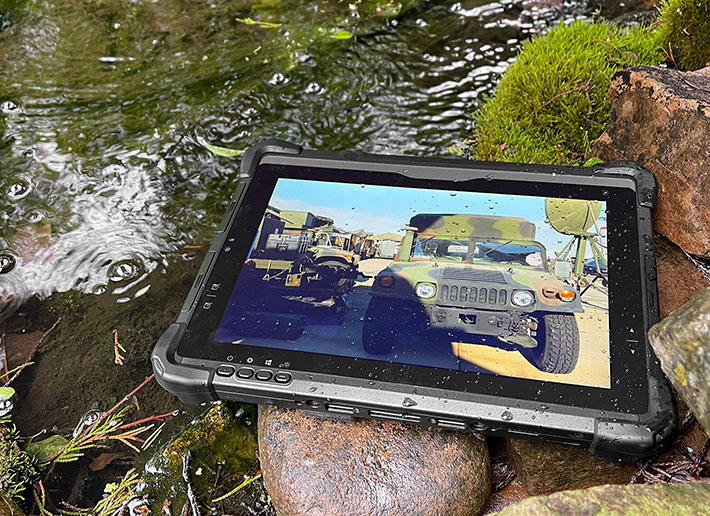
DT Research has kept the platfrom nicely updated over the years. The company first added a value-oriented version with an Intel Celeron processor (the DT301C), and then a high-performance version when Intel's 8th generation of Core processors brought quad-core processing to mobile systems (the DT301T). Then came the DT301X that added a sunlight-readable high-bright display and an optional Intel RealSense 3D camera for augmented reality applications. The DT301Y that's the subject of this review, added your choice of either an economical Intel Pentium Gold or one of two 11th generation "Tiger Lake" Intel Core processor.
Hybrid laptop/tablet designs are popular now due to their extra versatility, and DT Research was among the first to make 2-in-1 hybrid configurations with water-resistant detachable keyboards of its tablet platforms available to their customers. The company is also notable for skillfully combining field-oriented ruggedness and functionality with the elegance and ease-of-use of contemporary premium consumer tablets.
A timeless tablet solution for work and business
Let's start this examination with a look at what the DT301Y tablet looks like from the front and from all four sides. This provides an idea of what's similar to an iPad or a Samsung tablet, and where the design differs to offer the ruggedness and functionality required by a serious tool for jobs in the field and any place where substantial computing power is needed away from the office and the safety of a desk or briefcase.
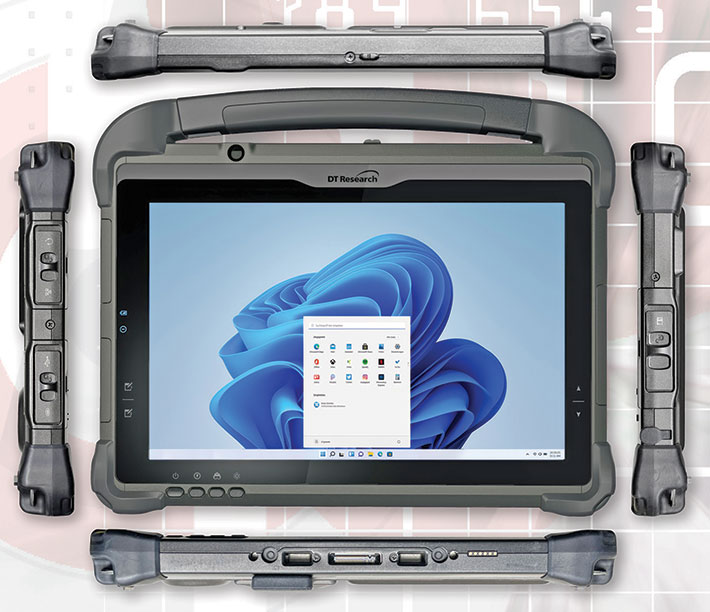
Note how for a fully rugged tablet with all the wired connectivity required of a modern Windows computer, the DT301Y is a comparatively compact design. It does show its age a bit here. There are, of course, the big protective bumpers that give rugged tablet the extra protection they need in the field. They are nicely integrated into the design and, unlike bumpers that are part of the housing, they are easy to replace.
There's a power/sleep button. A trio of hardware buttons bring up the Control Center screen, the Windows menu, and execute the "Security" modern day equivalent of the old alt-ctl-del. There are also four capacitive touch buttons integrated into the display bezel, two on the left and two on the right. A utility allows programming some of these buttons to whatever the job requires. Anything else is done onscreen.
Rugged tablets usually don't generally have a lot of onboard connectors because every opening to the vulnerable inside with all of its electronics is another area that needs to be sealed and protected. The DT301Y does, however, cover all the basics. On the left side are a single full-size USB 3.0 Type-A port, a reversible USB Type-C port, an RJ45 LAN jack, and a standard 3.5mm audio jack. On the right side is the power jack and also room for an optional Smart Card reader. Unlike on older versions of the DT301 where labels were underneath the protective doors, on the DT 301Y, the small white symbol icons are where they belong and can be seen -- on the protective doors.
What you won't find are fan cooling slots — the DT301Y doesn't have a (potentially noisy and troublesome) fan. Removing the heat of the high-performance electronics is done via clever thermal engineering.
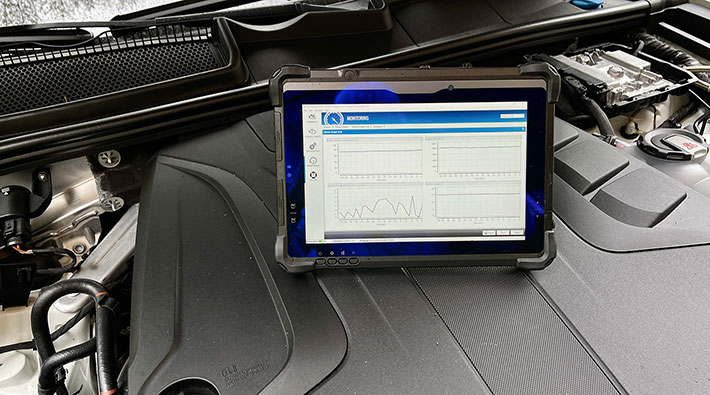
It's a 2-in-1 hybrid, and not just a tablet
Before getting into the performance aspects of the DT301Y, we'll touch on how DT Research early on decided to make their tablets more than just tablets. Company president Dr. Daw Tsai was quoted as saying "Mobile tablets are fast becoming the 'go to' computing device for the military and other field jobs. But as the use of mobile tablets has risen, we saw that users need the flexibility to use tablets in a variety of settings. Our 2-in-1 ultra-rugged tablets can dynamically adapt to indoor and outdoor use, while remaining light and durable with our signature fully-integrated design."
That's important. And it turned out it's also where the tablet market is going. Tablets (and to an even much larger extent smartphones) have revolutionized the world. But for a lot of field and office work, sitting down with a keyboard is still needed, and may always be needed. While you can theoretically use just about any wired or wireless keyboard with a tablet, it works so much better when you have a keyboard that's actually designed for use with that tablet. DT Research gave that much thought and created a simple keyboard solution that really works works well. It uses magnets to quickly and easily snap the keyboard into place.
The pictures below shows DT Research's implementation of the 2-in-1 concept, what it all looks like, and how it can be used. It's a clever solution that employs a fixed-angle bolt-on easel stand for the tablet. It doesn't allow for adjusting the viewing angle, but eliminates the clumsy top-heaviness of many 2-in-1 solutions.
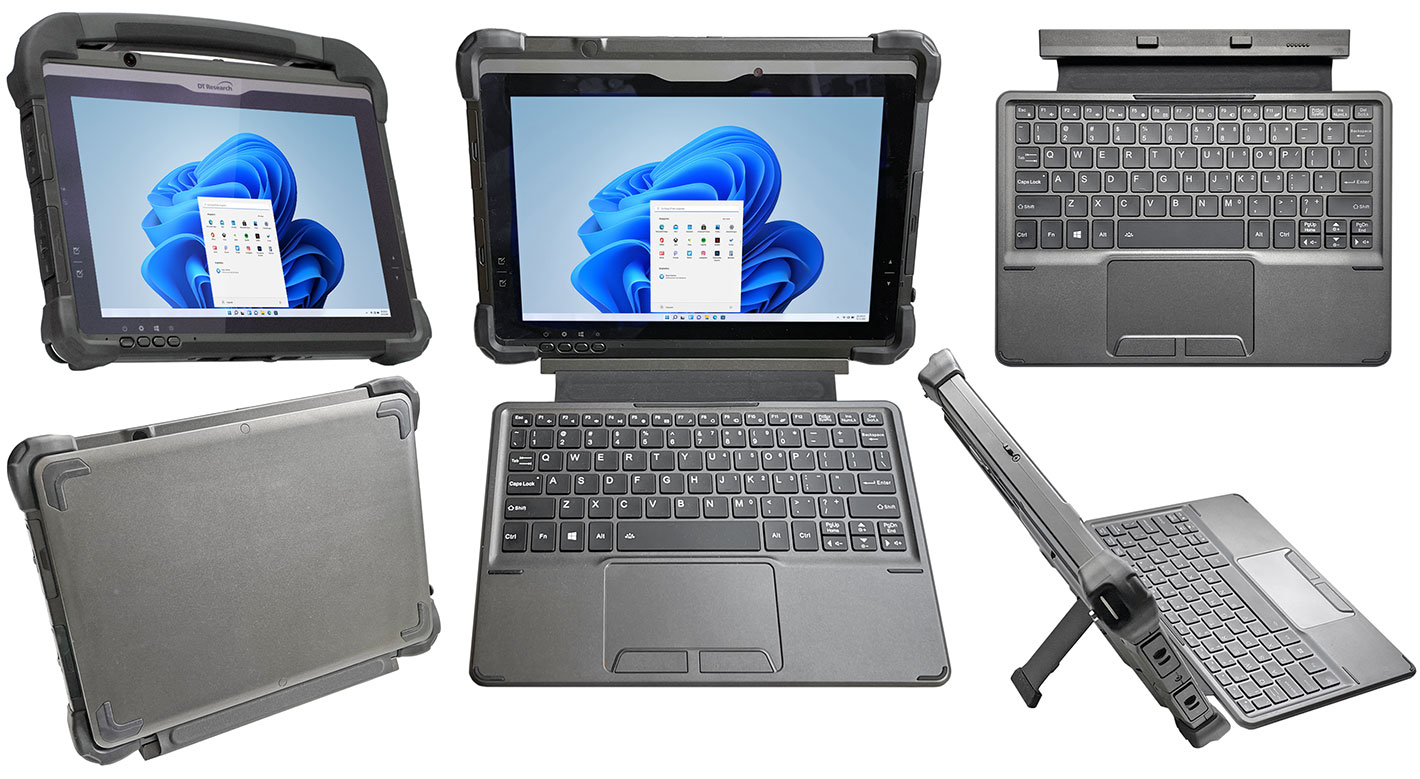
The detachable metal keyboard communicates via six surface mount spring-loaded pins, making for a quicker and more reliable connection than Bluetooth or other wireless methods. The keyboard, which perfectly matches the tablet in materials, color and texture, has 82 keys with the general look and feel of the slender Apple keyboard that has pretty much become the standard for modern keyboards, including 12 function keys. Touch typists will note, however, that the QWERTY letter layout is only 90% scale. In general, we like to see the standard full-scale layout on any physical keyboard. Even two or three finger typists have muscle memory.
Note that the 2-in-1 concept isn't new. It actually goes back all the way to the beginnings of pen computing and tablets in the late 1980s and early 1990s. Those early efforts didn't work well enough to catch on and become popular beyond a few niche markets. Among the problems was that early tablet computers were big and heavy, and adding a keyboard for a 2-in-1 solution made them even more so. In 2001, Microsoft promoted the "Tablet PC" concept, initially as pure tablets, but then as convertible notebooks. Those worked as laptops, but you could also flip the display around and make them into (still rather thick and heavy) tablets. More recently, cardboard-thin keyboards that attach magnetically to modern consumer and business tablets have made inroads, but generally don't make for truly practical solutions, and certainly not for industrial tablets.
Design and construction
As for the DT301 tablet series itself, it is one of the company's newer platforms. Its attractive, purposeful design clearly marks it as a rugged, businesslike piece of computing hardware. And the DT301 platform is flexible enough for DT Research to offer versions with different types of Intel processors, even from different generations, providing various levels of performance in one and the same fanless package. Further, in contrast to the "bolt-on" model, the approach DT Research took is one of "pre-integrating" modular hardware that precludes compatibility testing, loss or theft of biolt-ons, and can often make for more seamless data capture.
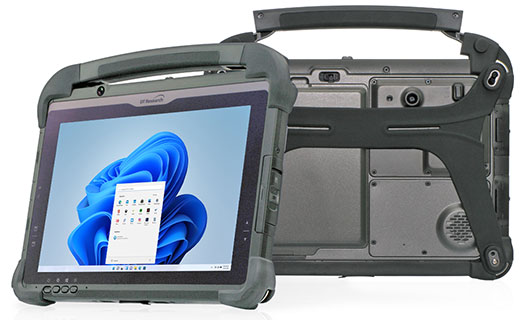 Measuring about 11 x 7.8 x 0.86 inches and weighing around three pounds, the DT301Y version has a hot-swappable 61.6 watt-hour battery, and now comes with Wi-Fi 802.11ax and Bluetooth 5.2. Optionally available are a 4G LTE/AWS mobile broadband module, a standard or Intel RealSense 3D rear camera, a 1D/2D barcode scanner, and long distance BlueTooth. Since some DT301 tablet options (like the scanner) replace part of the onboard wired connectivity, DT Research offers an optional desktop dock that adds dual DisplayPort outputs that support 4K UHD resolution, four USB ports, and RJ45 LAN. Measuring about 11 x 7.8 x 0.86 inches and weighing around three pounds, the DT301Y version has a hot-swappable 61.6 watt-hour battery, and now comes with Wi-Fi 802.11ax and Bluetooth 5.2. Optionally available are a 4G LTE/AWS mobile broadband module, a standard or Intel RealSense 3D rear camera, a 1D/2D barcode scanner, and long distance BlueTooth. Since some DT301 tablet options (like the scanner) replace part of the onboard wired connectivity, DT Research offers an optional desktop dock that adds dual DisplayPort outputs that support 4K UHD resolution, four USB ports, and RJ45 LAN.
Anyone who doesn't need the extra screen space of a "pro" size tablet, such as DT Research's own 11.6-inch DT311H or 14-inch DT340T, will feel instantly at home with the 10-inch class DT301Y. Its footprint is reminiscent of the ubiquitous original iPad, and it offers the same full-HD 1920 x 1200 pixel resolution as the larger DT311H. Like virtually all modern Windows tablets, the DT301Y has capacitive multi-touch, and DT Research also offers an active digitizer with a high-precision digital pen.
No RuggedPCReview examination of a rugged device would be complete without taking it appart. In our experience, products from established, reputable manufacturers of rugged mobile computing gear have nothing to fear from a detailed interior inspection. These devices are designed from the ground up to be rugged, and we seldom come across unpleasant surprises. But sometimes we do notice something that catches our attention and we may discuss the matter with the manufacturer.
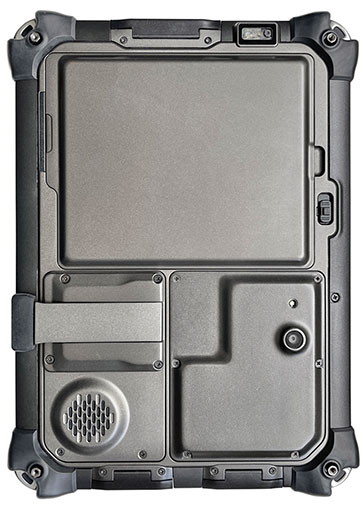 The picture to the right shows the backside of the DT301Y with its rubber hand strap removed. The picture to the right shows the backside of the DT301Y with its rubber hand strap removed.
As far as power goes, the externally accessible and easily replaceable DT301Y battery uses Lithium-Ion technology and is rated 11.4 Volts and 5,400 mAH. Its 61.6 watt-hours is a good match for a tablet in this performance class. The advantage of this type of battery design is that it's easy to offer optional higher capacity batteries, like the 91.2 watt-hour high capacity battery DT Research offers for the DT301Y (as well as the older DT301T and DT301X).
The DT301Y battery is custom-designed for the DT301 platform and is part of the tablet, i.e. there is no cover over it. The battery compartment itself isn't sealed, but the connector between the battery and the insides of the tablet is, and that's all that matters. The battery is securely held in place with a combination friction lever/lock.
The removable access cover on the bottom right (see image below) houses the optional rear-facing 8mp documentation camera with LED flash. Inside the cover is also where the optional small 1.85 watt-hour uninterruptible power battery goes that makes hot-swapping the main battery possible.
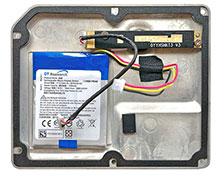 The removable access cover to the left includes the sealed speaker as well as the optional easel stand of the tablet. Once the cover is off, you also have access to the tablet's MicroSD card slot, the quick-release solid state disk with its heatsink housing, the WiFi/Bluetooth module, and the miniPCIe slot that can be used for a 4G LTE/AWS mobile broadband module. The removable access cover to the left includes the sealed speaker as well as the optional easel stand of the tablet. Once the cover is off, you also have access to the tablet's MicroSD card slot, the quick-release solid state disk with its heatsink housing, the WiFi/Bluetooth module, and the miniPCIe slot that can be used for a 4G LTE/AWS mobile broadband module.
Taking a DT301 series tablet apart isn't totally trivial. You start with removing the corner rubber bumpers, all the plastic antenna covers, and the protective I/O covers. That's not inherently difficult, but means undoing a significant number and variety of different screws and bolts. Once all of those are taken care of (make sure you keep track of all the many parts and screws!), the two halves of the DT301 are secured against each other with just three more small screws and then come apart fairly easily. Caution is required though as there are three cables (power, CAC reader in some DT301 versions, and speaker) that must be disconnected before the two halves fully separate.
The overall construction of the DT301 platform now reveals itself. Except for the front bezel overlay, pretty much the entire tablet is solid magnesium-aluminum alloy. Solid as in beefy and heavily reinforced, not the fragile lightweight kind sometimes found in premium consumer tablets. Below you can see the two structural halves of the DT301Y tablet, backside on the left and frontside on the right.
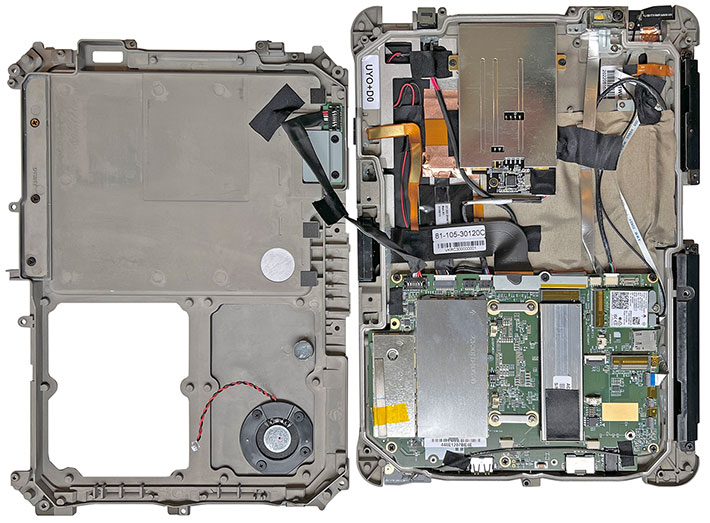
The ever important sealing between the two magnesium halves is via a complex 3D tongue-and-groove design that goes around the perimeter. In the groove sits a replaceable rubber seal.
All major components are mounted on the two sides of the magnesium front half of the tablet, display on one side and electronics on the other. The motherboard measures about 6.5 x 4 inches. It's clearly a custom design for this particular tablet, cut and contoured to fit precisely into its space inside the magnesium frame.
In older versions of the DT301 platform, what immediately caught the eye was a curved length of copper heat tubing embedded in the magnesium frame. You no longer see that in the DT301Y as it's covered up somewhere, but we're sure it's still there. That's because the DT301Y is a fanless design, even with its powerful Intel "Tiger Lake" quad-core processor. The two available quad-core chips have a TDP (Thermal Design Power) of 15/28 watts, which is quite a bit of heat to dissipate. Being able to do that without a fan is remarkable. And, of course, mens no fan noise, no potentially undesirable air streams, and no mechanical fan that can get clogged or fail. The pictures below were taken with our FLIR One Pro infrared camera during a strenuous PCMark 10 performance test benchmark run.
The bright yellow areas are the hottest, the orange and red areas cooler. In each of the four frames the red dot shows the highest temperature detected. What's amazing here is that even when running a demanding performance benchmark, the tablet nothing on the outside of the tablet even reached 90F. That's remarkable for a passively cooled system without a fan. Things can get hotter outside on a hot day, or during prolonged heavy use, but the thermal design seems up to the task.
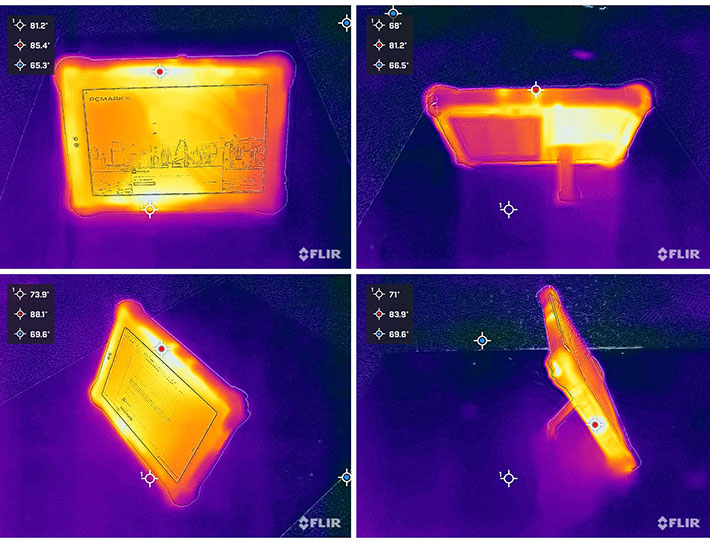
Whatever I/O there is — USB 3.0, USB Type-C, an audio jack, and power — is edge-mounted on the motherboard. There are just a few visible wires, all leading to the various antennae that are located outside of the sealed metallic inner sanctum of the tablet. That's because antennae can't work inside a full metal enclosure. As is usually the case, parts of the motherboard and other electronics are underneath metal shielding. What's impressive is that each of those shields is individually engraved with its number, purpose and that it's for the DT301Y.
The overall layout is logical and well done. This is certainly no generic design. Everything is custom and as complex and refined as it needs to be to get the job done. Sealing a device of this complexity isn't easy, not with four different radio antenna that all must be outside the actual interior enclosure. To still reach IP65 ingress protection is quite an achievement.
Always the right processor for the job
It must be a bit frustrating for makers of rugged laptops and tablets to have their processor supplier — Intel — come up with a new generation of chips pretty much every year. That sort of rapid-fire release of new products, which makes the older ones obsolete, works well for consumer mass markets where customers expect something newer and faster and more exciting every season. Vertical markets have longer product life cycles and lower purchase volumes, and that means 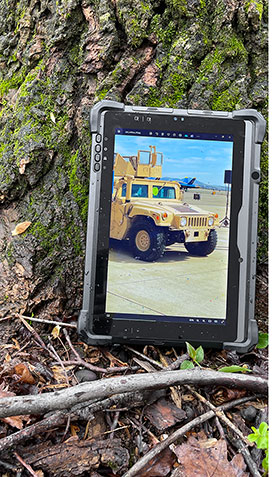 rugged computer makers can quickly find themselves two or three or even four processor generations behind. That's not always a big deal, because new Intel chip generations are often just optimizing and fine-tuning older tech. But no one wants to be behind. rugged computer makers can quickly find themselves two or three or even four processor generations behind. That's not always a big deal, because new Intel chip generations are often just optimizing and fine-tuning older tech. But no one wants to be behind.
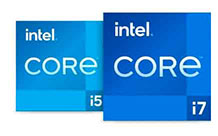 DT Research has been making rugged systems long enough — almost 30 years — to know how to play that game. They design their platforms such that they can not only accommodate lower and higher end processors, but are also (relatively) easy for the company to keep up to date. As a result, DT301 platform models have been available with CPUs from almost half a dozen Intel Core processor generations! Early models used 6th and 7th generation chips, then the 8th generation that brought the first mobile quad-core chips, then the 10th generation, the milestone "Tiger Lake" 11th generation in the DT301Y, and it appears that the company will continue to update the platform with the latest Intel processor tech. DT Research has been making rugged systems long enough — almost 30 years — to know how to play that game. They design their platforms such that they can not only accommodate lower and higher end processors, but are also (relatively) easy for the company to keep up to date. As a result, DT301 platform models have been available with CPUs from almost half a dozen Intel Core processor generations! Early models used 6th and 7th generation chips, then the 8th generation that brought the first mobile quad-core chips, then the 10th generation, the milestone "Tiger Lake" 11th generation in the DT301Y, and it appears that the company will continue to update the platform with the latest Intel processor tech.
The 11th generation "Tiger Lake" chips have been around for over three years by now, 12th (Alder Lake) and 13th (Raptor Lake) chips are available, and the 14th generation "Meteor Lake" just are just around the corner. Does that make the current DT301Y obsolete? Hardly. "Tiger Lake" was a milestone generation for Intel, and 11th gen chips will continue to be strong and competitive performers for several years to come, and we suspect that DT Research may well update the DT301 yet again some time in the not too distant future.
To provide an idea of where the DT301Y with its Intel 11th generation Core i7 chip stands in terms of performance, we ran it through all of our benchmark suites (PassMark 6.1 and PassMark 9, CrystalMark, PCMark 10, 3DMark, and GeekBnech). For comparison we're also listing the results of some of the competition's high-performance tablets: Dell's Latitude 7030 and 7230 Rugged Extreme Tablet, the Getac UX10, Handheld's 10XR and the xTablet T1175 from MobileDemand. Here are the results:
|
DT Research DT301Y rugged tablet vs 10-inch class rugged tablets
|
|
Company
|
DT Research
|
Dell
|
Dell
|
Getac
|
Handheld
|
Mobile Demand
|
|
Model
|
DT301Y
|
7030
|
7230
|
UX10
|
10XR
|
T1175
|
|
Year tested
|
2024
|
2024
|
2023
|
2021
|
2023
|
2024
|
|
CPU Type
|
Intel Core
|
Intel Core
|
Intel Core
|
Intel Core
|
Intel Atom
|
Intel Core
|
|
CPU model
|
i7-1165G7
|
i7-1260U
|
i5-1240U
|
i7-10510U
|
x6413E
|
i5-1335U
|
|
Display size
|
10.1-inch
|
10.0-inch
|
12.0-inch
|
10.1-inch
|
10.1-inch
|
10.1-inch
|
|
Resolution (pixels)
|
1920 x 1200
|
1920 x 1200
|
1920 x 1080
|
1920 x 1200
|
1920 x 1200
|
1920 x 1200
|
|
Luminance
|
890 nits
|
1,195 nits
|
1,337 nits
|
1004 nits
|
930 nits
|
688 nits
|
|
Footprint (inches)
|
11.00 x 7.80
|
10.36 x 7.40
|
11.65 x 8.00
|
10.8 x 7.5
|
11.1 x 7.1
|
11.54 x 7.56
|
|
Thickness (inches)
|
0.86
|
1.00
|
0.94
|
0.88
|
1.0
|
0.67
|
|
Volume (cu-in)
|
71.0
|
76.7
|
87.6
|
71.3
|
78.8
|
58.5
|
|
Weight as tested
|
3.10 lbs
|
2.24 lbs
|
2.76 lbs
|
2.68 lbs
|
2.70 lbs
|
2.73 lbs
|
|
Cooling
|
Fanless
|
Fan
|
Fan
|
Fan
|
Fanless
|
Fan
|
|
Operating temp
|
14° to 140° F
|
-20° to 145° F
|
-20° to 145° F
|
-20° to 145° F
|
-4° to 140° F
|
-14° to 122° F
|
|
IP rating
|
IP65
|
IP65
|
IP65
|
IP65
|
IP65
|
IP65
|
|
PassMark 6.1
|
5,843
|
7,624
|
8,364
|
6,627
|
2,636
|
8,240
|
|
PassMark 9.0
|
4,787
|
5,607
|
5,516
|
3,869
|
1,917
|
5,067
|
|
CrystalMark
|
448,119
|
465,144
|
401,322
|
315,866
|
210,757
|
465,528
|
|
PCMark 10 Overall
|
4,837
|
5,052
|
4,847
|
3,869
|
2,344
|
4,801
|
|
PCMark 10 Disk
|
2,405
|
2,184
|
2,015
|
1,949
|
665
|
1,838
|
|
PCMark 10 Battery
|
9:31 hrs
|
8:16 hrs
|
11:51 hrs
|
NA
|
3:37 hrs
|
6:01 hrs
|
|
Watt-hour per hour
|
6.47
|
4.35
|
6.01
|
NA
|
7.77
|
10.64
|
|
3DMark TimeSpy
|
1,121
|
1,383
|
1,142
|
414
|
208
|
1,237
|
|
GeekBench 5 single
|
1,453
|
1,562
|
1,496
|
1,123
|
661
|
1,565
|
|
GeekBench 5 multi
|
3,843
|
7,001
|
7,049
|
2,839
|
1,899
|
4,810
|
|
GeekBench 5 Open CL
|
11,150
|
13,525
|
10,713
|
NA
|
2,104
|
12,377
|
The tablets listed above are all premium rugged tablet products that pack the performance level expected from their target markets. There is generally remarkable performance parity among the highest performance versions of each product line in that class. As of this writing, the tablets represent no fewer than four different Intel Core processor generation, and one tablet relying on a lower performance Intel Atom processor that's adequate for their market.
Given that, compared to its primary competition, the DT301Y is the only fanless device and still at the 11th processor generation, the tablet is a very good performer. Fanless systems, which don't have the potential drawbacks of an active fan, are generally tuned more conservatively so as not to overheat in extreme conditions. DT Research did a very good job at performance-optimizing this tablet. What contributes to it is that the DT301Y excels in disk subsystem performance (which can often make or break overall performance).
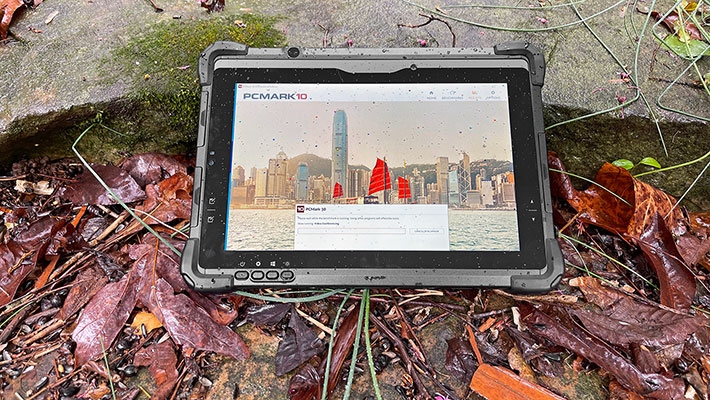
Battery life
Back in the early days of mobile computing, high performance in the field pretty much meant short battery life. Advances in processor, display and battery technology have changed that for the better, but how long could the high-performance DT301Y with its bright display possibly last on a charge of its battery? To find out we used Passmark Software's BatteryMon benchmark utility to measure the DT Research tablet's power draw under various operating conditions.
Usually we measure draws both at the economy as well as the maximum performance setting, but our DT301Y only had a "balanced" setting. With display brightness put to its lowest setting (0%), we saw an idle power draw of 5.1 watts. We then cranked the backlight up to 50%, and draw increased to 7.3 watts. Then we raised brightness all the way up to 100% and saw a power draw of 9.6 watts. That's with the tablet being awake, just idling along.
|
DT Research DT301Y Power Draws (at idle)
|
|
Backlight level
|
Lowest (0%)
|
50%
|
Maximum (100%)
|
|
Balanced
|
5.1 watts (12.1 hrs)
|
7.3 watts (8.4 hrs)
|
9.6 watts (6.4 hrs)
|
As the table on the right shows, with the DT301Y's standard 61.6 watt-hour battery those draws would translate into 12.1 hours at the lowest backlight setting, 8.4 hours with the backlight at 50%, and 6.4 hours with the backlight at its highest setting. The optional 91.2 watt-hour battery offers 50% more capacity, and that would increase those run times to 16.15, 12.6, and 9.6 hours.
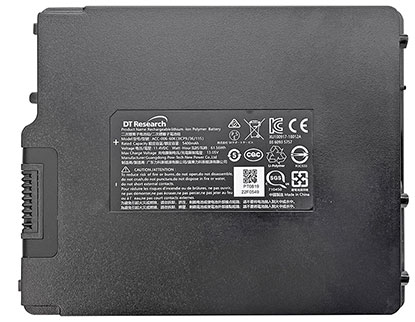 The power draws we measured on the DT301Y are actually higher than those of the older DT301X model with its Intel 8th generation quad-core i7-8550U processor. Possible reasons are the new model's brighter display (nominally 1000 vs 800 nits) and higher performance (33% higher in the PassMark 9.0 benchmark). And there are any number of variables that could come into play. BatMon, of course, only measures battery draw at idle, which means it shows how long the system would run, always on, but just idling along. The power draws we measured on the DT301Y are actually higher than those of the older DT301X model with its Intel 8th generation quad-core i7-8550U processor. Possible reasons are the new model's brighter display (nominally 1000 vs 800 nits) and higher performance (33% higher in the PassMark 9.0 benchmark). And there are any number of variables that could come into play. BatMon, of course, only measures battery draw at idle, which means it shows how long the system would run, always on, but just idling along.
A better measure of the tablet's battery life while being used is the PCMark 10 Battery test. This test continually exercises the system with a variety of typical office and field work, such as web browsing, wordprocessing, spreadsheets, graphics and more. In that test, the DT301Y ran for 9:31 hours, consuming 6.47 watt-hours per hour. That means the DT301Y could easily make it through a full shift on a charge, even while being continually being used. That's very good.
Bright, excellent 10.1-inch full HD display
The DT301Y tablet's 10.1-inch display offers full HD 1920 x 1200 pixel resolution, making for a 16:10 aspect ratio and a sharp 224 pixels per inch. The display surface is of the glossy variety seen today on virtually all tablets and smartphones. Indoors, the DT301Y display is very pleasant to use and work on, and full brightness is never needed. Outside viewability depends on lighting conditions, reflections, contrasts, viewing angles and more.
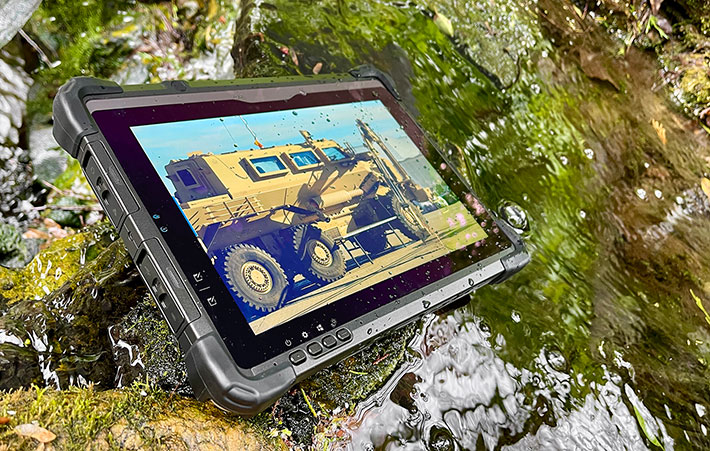
Not too long ago, outdoor viewability was the weak point of most rugged mobile computing devices. Display technologies — reflective, transflective, hybrids and others — came and went, none getting close to providing more than barely acceptable results. Eventually the industry decided that modifying conventional transmissive LCDs for daylight and sunlight use was the best currently available way to go.
That's done by reducing the display's internal reflection of ambient light so that, in conjunction with a reasonably strong backlight, there is enough contrast to make the screen viewable outdoors. This reduction of internal reflection is accomplished via a combination of polarizers, filters, coatings and elimination of air spaces between the various layers of the LCD.
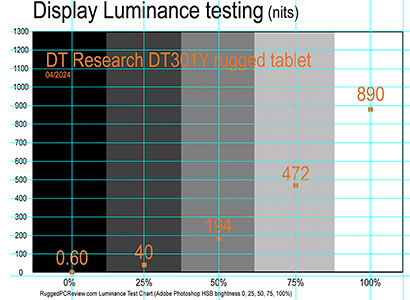 Almost all mobile devices use this technology today, but the exact implementation varies from manufacturer to manufacturer. As does the strength of the backlight (a stronger backlight means a larger battery or shorter battery life).
Almost all mobile devices use this technology today, but the exact implementation varies from manufacturer to manufacturer. As does the strength of the backlight (a stronger backlight means a larger battery or shorter battery life).
Backlight strength varies with the type of device. Desktop monitors and standard notebooks are usually in the 200 nits range. Modern smartphones and tablets are between 400 and 600 nits. Rugged laptops are available with as much as 1,500 nits. Cranking luminance up too high can make for a washed-out look and quickly drains batteries. So DT Research settled on 1000 nits for the DT301Y, up from 800 nits on the DT301X.
The graph to the right shows how the tablet did in our luminance test. At full black we measured just 0.6 nits, at full white we saw as high as 890 nits, somewhat less than the 1000 nits in the specs. That may be due to loss via some of the coatings.
The picture below shows the DT301Y outdoors on a bright day with the backlight cranked all the way up to 100%. Like all "glossy" displays, The DT301Y's shows reflections, that's just in the nature of the technology. What's unusual is the blue and purple cast of the reflection, likely as the result of some of the coatings.
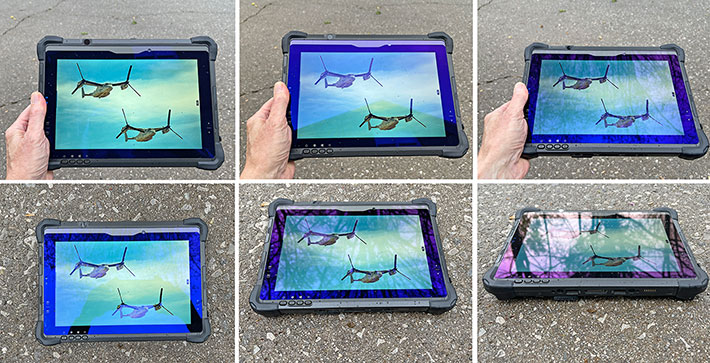
Overall, the display of the DT301Y works well and is pleasant to use. It's bright enough, it has near perfect viewing angles, there are no contrast and color shifts when viewing even from extreme angles, and reflection control is as good as it currently gets.
Optional cameras
As is the case these days with all smartphones and tablets, the DT301Y has integrated cameras. They are options, but in this day and age of video conferencing, having onboard cameras is pretty much mandatory (the older DT301X actually did not have a front camera).
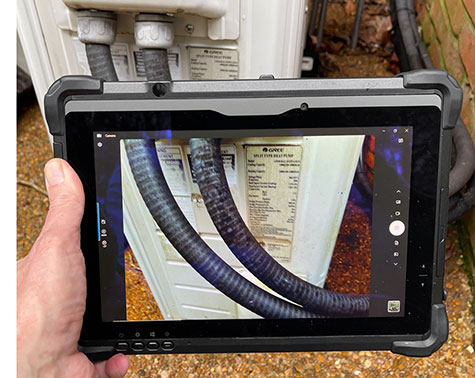 The front camera has a 2MP imager, the rear documentation camera 8MP, auto focus, white balance, gain control, and exposure control. DT Research also offers an Intel RealSense Depth back camera that supports distance capture for 3D scanning, environment sensing, and background segmentation applications. This is an emerging technology whose application potential is limited only by imagination. As an example, DT Research lists real-time 3D imaging that can create very accurate measurements for use by crime scene forensics teams. The front camera has a 2MP imager, the rear documentation camera 8MP, auto focus, white balance, gain control, and exposure control. DT Research also offers an Intel RealSense Depth back camera that supports distance capture for 3D scanning, environment sensing, and background segmentation applications. This is an emerging technology whose application potential is limited only by imagination. As an example, DT Research lists real-time 3D imaging that can create very accurate measurements for use by crime scene forensics teams.
Our review unit came with the regular 8-megapixel camera and uses the Windows Camera app that records images at 3264 × 2448 pixel resolution.
Video defaults to 1920 x 1080 at 30 frames per second but here you can switch to 2448p video in 4:3 format, which means the same 3264 × 2448 pixels as the fixed still resolution. That's actually close to the same pixel count as 4k video (3840 x 2160), only in a 4:3 aspect ratio instead of the common 16:9 wide format.
In still photography, auto-focus was a bit of a mystery, sometimes focusing as it should, other times seeming uncertain. Most PC cameras allow tapping on the subject you want to focus on, but that feature isn't available here. Most, but not all, test images were reasonably to very sharp, the camera did not over-compress images, and operation was quick. The same applied to video. What's missing is frame rates higher than 30 fps. Those come in handy for slow-motion.
The pictures below were taken with the DT301Y's camera in its highest 4:3 aspect ratio 3264 × 2448 pixel resolution (click on the sample pics for a full-size version of the entire picture compilation).

With almost everyone carrying a smartphone in their purse or pocket, integrated cameras are no longer as important as they once were. The 8mp camera in the DT301Y can be useful; the limiting factor is the very marginal Windows camera app. The Intel RealSense Depth camera option, however, is a different and more interesting animal. That has significant potential.
Docks, accessories, and peripherals
Since the DT301 tablet platform doesn't offer the onboard wired connectivity of a rugged laptop, DT Research offers a handy, compact optional desktop dock that adds dual DisplayPort outputs that support 4K UHD resolution, four USB ports, and RJ45 LAN.
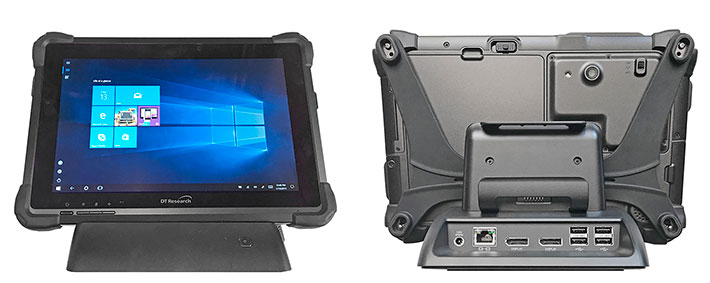
Other accessories include a DisplayPort-to-DVI adapter that also enables running dual external displays off the dock; a wall/vehicle cradle with LAN pass-through and two USB ports that accepts power through a cylindrical 19V plug or a 12V-24V pluggable Phoenix terminal block connector. We've covered the 2-in-1 keyboard earlier in this review, and DT Research also offers a separate keyboard tray with a USB keyboard for use with the wall/vehicle cradle.
Elegant tablet that can take a beating
Hundreds of millions are using tablets now, but most of those tablets are consumer-grade designs too fragile for field or even enterprise use. That's why there are rugged tablets like the DT301Y. Ruggedness, however, increases size, weight and cost. So designers and manufacturers of rugged, heavy-duty tablets aim for just the right balance: Tough enough for the job, light and handy enough for easy use, but still affordable to fit into budgets.
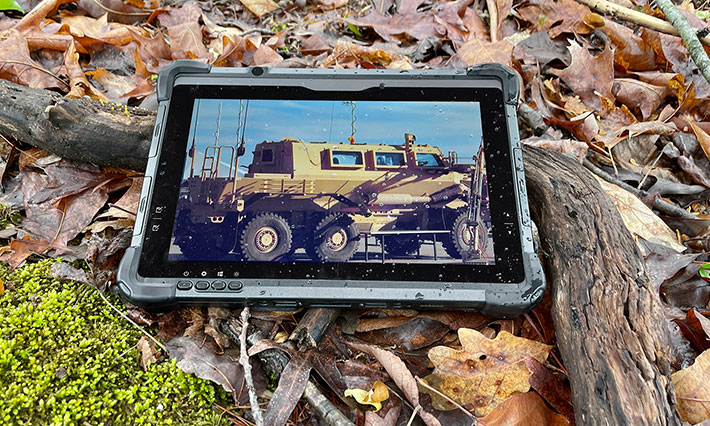
Thanks to its ABS+PC polycarbonate and magnesium-aluminum alloy construction, the DT301Y is inherently very solid. And according to DT Research, the DT301Y's entire enclosure has antimicrobial properties. That can be mandatory in certain vertical markets.
Ingress protection is at the IP65 level, which means the device is fully protected against dust, and also protected against low pressure water jets from all directions. IP65 is the norm for rugged tablets in this class. It allows using the tablet in the rain, it won't get damaged sitting in a puddle or being washed off. Do make sure, though, that the protective doors are closed when using the tablet in wet conditions.
The standard operating temperature range is a very wide -14 to 140 degrees, making the system deployable almost anywhere, including in commercial freezers. If even higher low temperature tolerance is required, there's a -22F option.
DT Research also claims MIL-STD-810H testing for drop, shock and vibration, as well as MIL-STD-461F certification for EMI and EMC tolerance. Here it would be good to see more detailed information in the spec sheet and promotional materials. Customers are interested in rugged tablets because they can handle more abuse, so specific information on just how much abuse should be included.
With its heavy-duty magnesium frame inside and the hefty rubber corner guards outside, the DT301 platform is clearly designed to handle a good deal of punishment. The tablet feels solid and trust-inspiring, too, without any flex or creaking. That said, it would be good to know what sort of strengthened glass DT Research used and also what sort of scratch resistance the elegant metallic and plastic surfaces provide.
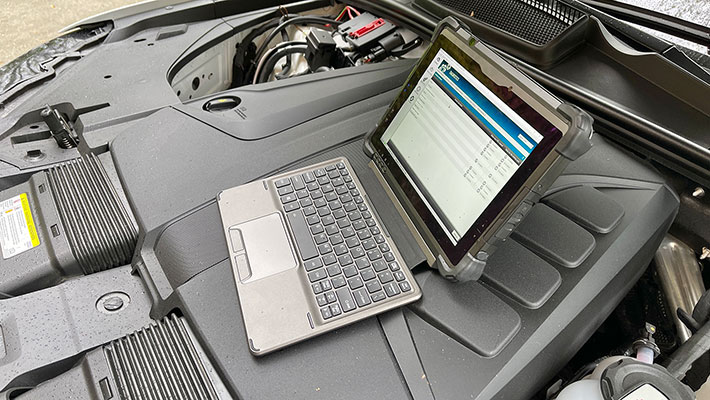
Summary: DT Research DT301Y rugged 2-in-1 tablet computer
With the DT301Y version of its DT301 thin-and-light rugged tablet platform, DT Research offers a versatile state-of-the-art tablet and 2-in-1 computing tool that's tough enough for in numerous vertical markets that require more durability and resistance to harsh environmental conditions than consumer tablets can provide, even if they are in a case.
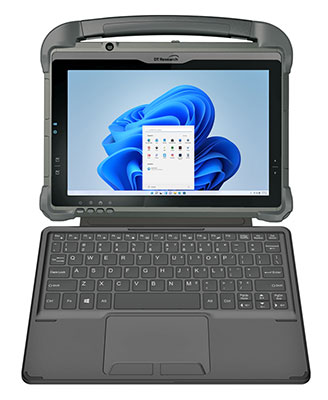 As a tablet, the Intel 11th generation quad-core processor powered DT301Y offers a very bright, daylight-viewable 10.1-inch capacitive multi-touch display with full HD resolution, perfect viewing angles from all directions, and an optional active pen with a pencil-thin, pressure-sensitive tip. As a tablet, the Intel 11th generation quad-core processor powered DT301Y offers a very bright, daylight-viewable 10.1-inch capacitive multi-touch display with full HD resolution, perfect viewing angles from all directions, and an optional active pen with a pencil-thin, pressure-sensitive tip.
Weighing around three pounds, the attractively designed magnesium-alloy tablet is tough and well protected.
Equipped with a full-size USB 3.0 Type-A and a reversible USB Type-C port, 3.5mm audio jack, and an RJ45 LAN jack, the DT301Y can be custom configured with a standard or an Intel RealSense rear camera, a user-facing vidcam, 1D/2D barcode scanning, long-range Bluetooth, mobile broadband, as well as discrete GNSS.
The optional detachable keyboard converts the DT301Y into a hybrid 2-in-1 device that can instantly provide full laptop functionality without the extra bulk and weight of a permanently attached keyboard.
An optional desktop dock provides dual DisplayPort outputs capable of 4K UHD resolution, four USB ports, and RJ45 LAN. A wall/vehicle cradle with USB keyboard tray is available as well.
All of this combines into a modern, state-of-the-art Windows 10/11 2-in-1 tablet hybrid solution with the performance required for even the most demanding field applications. -- Conrad H. Blickenstorfer, April 2024
|
DT Research DT301Y Specifications
|
| Status |
Full review DT301Y 04/2024
|
| Type |
Rugged Mobile 2-in-1 Windows tablet
|
| Processor |
Quad-core Intel "Tiger Lake" Core i7-1165G7 or
Quad-core Intel "Tiger Lake" Core i5-????G7 or
Dual-core Intel "Tiger Lake" Pentium Gold 7505
|
| CPU Speed |
Core i7-1165G7: default/max turbo frequency = 1.20GHz/4.80GHz
Core i5-????G7: default/max turbo frequency = 1.20GHz/4.80GHz
>
Pentium Gold 7505 default/max turbo frequency = 2.00GHz/3.50GHz
|
| Graphics |
Core i7-1165G7: Intel Iris
Core i5-????G7: Intel Iris
Pentium Gold 7505: Intel UHD Graphics for 11th Gen Intel Processors
|
| CPU Thermal Design Power |
Core i7-1165G7: 15/28 watt
Core i5-????G7: 15/28 watt
Pentium Gold 7505: 15 watt
|
| OS |
Microsoft Windows 10/11 IoT Enterprise
|
| Memory |
8GB to 32GB
|
| Storage |
256GB to 2TB Flash (test unit had 256GB PCIe NVMe SSD)
|
| Display |
Outdoor-viewable TFT with LED backlight, 1000 nits luminance, anti-reflection coating |
| Display Size/Resolution |
10.1-inch/1920 x 1200 pixel FHD (224 ppi) |
| Digitizer |
Capacitive multi-touch, optional active digitizer/pen with replaceable 1.5mm tip (uses AAAA battery) |
| Keyboard |
Optional detachable 81-key keyboard, 3 programmable buttons, RF button |
| Navigation |
Stylus, touch |
| Expansion slots |
NA |
| Housing |
ABS+PC bezel; magnesium structure/frame |
| Size |
11.0 x 7.8 x 0.86 inches (280 x 198 x 22 mm) |
| Weight |
3.1 lbs. (1.4kg) |
| Operating temperature |
-14° to 140°F (optional -22° to 140°F)
|
| Ingress protection |
IP65 |
| Altitude |
unknown
|
| Drop/shock |
MIL-STD-810H (4-foot drop) |
| Vibration |
MIL-STD-810H |
| Regulatory |
FCC Class B, CE, RoHS compliant |
| EMC |
MIL-STD-461F |
| Power |
Hot-swappable 11.4V 5,400 mAH Li-Ion (61.6 watt-hours); optional hot-swappable 11.4V 8,000 mAH Li-Ion (91.2 watt-hours)
|
| Cameras |
Optional: front-0facing 2mp camera, rear-facing 8mp back AF camera with LED flash, optional 3D Intel RealSense camera
|
| Data capture |
Optional: 1D/2D barcode scanner, HF/RFID 13.56MHz reader
|
| Sensors |
Accelerometer
|
| Interface |
1 x USB 3.0, 1 x USB Type-C, 1 x RJ45 LAN, 1 x 3.5mm audio in/out, power
|
| Wireless options |
Intel Dual Band Wi-Fi 802.11ax, 2.4GHz/ 5GHz dual band, Bluetooth v5.2 (optional Class 1 (1,000 feet) BT available), optional: 4G LTE/AWS; ublox M9N GNSS module
|
| Price |
Inquire |
| Product page |
DT301Y web page |
| Spec sheet |
 DT301Y datasheet (PDF) DT301Y datasheet (PDF)
|
| Warranty |
1, 2, or 3 year extended or no-fault options
|
|
Contact
|
DT Research
2000 Concourse Drive
San Jose, CA 95131, USA
Tel: (408) 934-6220
Fax: (408) 934-6222
Web: www.dtresearch.com
|
(copyright 2024 RuggedPCReview.com)
|
|
|






